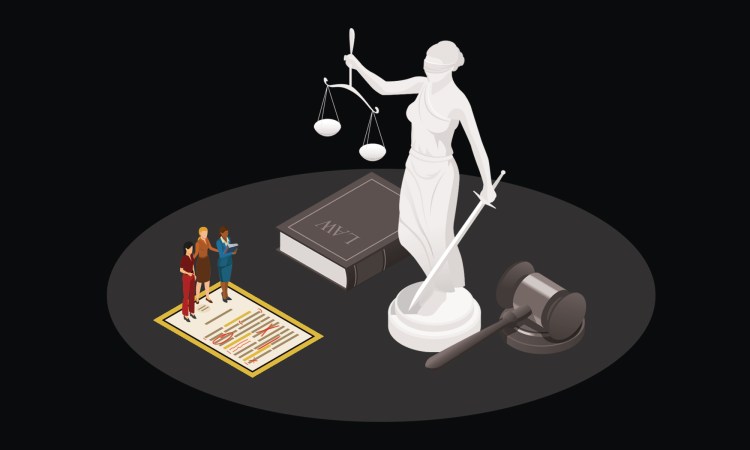
The ERA is more relevant and important than ever. By making women fully equal under the law, the US could better address sexual assaults and gender violence, says attorney Laura L. Dunn.
Laura L. Dunn’s legal career arose from a personal struggle for justice.
When Dunn was a freshman in college, two crew teammates raped her. She responded by reporting it to campus authorities. “I did what a lot of survivors do; I believed in the systems,” she recalls. “I thought if I reported it to the police and to my campus, then everything would work out and I would receive justice.”
But the state prosecutor chose not to pursue charges, and her university failed to punish the alleged perpetrators. Then, when Dunn turned to the US Department of Education to file a Title IX complaint, it ended up upholding the university’s actions. “I learned then what many survivors are learning now, every single day: that the system doesn’t necessarily serve the most vulnerable — those who are victimized,” she says.
Now Dunn is a victim’s rights attorney and DC managing counsel at The Fierberg National Law Group in Washington, DC (and a TED Fellow). In 2014, Dunn founded the national nonprofit SurvJustice, which offers legal assistance to campus sexual assault survivors, advocates for better victims’ rights policies, and trains institutions to prevent and respond to sexual violence. In January 2018, SurvJustice sued Education Secretary Betsy Devos, the US Department of Education, and Assistant Secretary for Civil Rights Candice Jackson for its rollback of Title IX protections for sexual misconduct survivors.
Dunn believes US law needs to go further to protect victims of sexual violence. She is pushing for passage of the Equal Rights Amendment (ERA), a proposed constitutional amendment which reads, “Equality of rights under the law shall not be denied or abridged by the United States or by any state on account of sex.” Back in the 1970s, the ERA was supported by both major political parties, as well as president Nixon (and later presidents Ford and Carter). In 1972, the House of Representatives and the Senate approved the ERA.
But in order to become law, three-fourths of the 50 states must ratify Constitutional amendments via their legislatures. The ERA fell just three states short of the 38 states needed before its ratification deadline. Now, more than three decades later, the ERA is making a comeback. Nevada ratified the amendment in 2017, the first state in almost four decades to do so. Illinois did the same in May 2018, making the ERA only one state away from passage.
Sad but true: the US Constitution does not explicitly guarantee equal rights for women. In 1776, as the Founding Fathers were debating the Declaration of Independence, Abigail Adams famously asked husband John Adams, “In the new code of laws . . . I desire you would Remember the Ladies, and be more generous and favorable to them than your ancestors.” Adams’ response? “I cannot but laugh.”
Existing Constitutional amendments don’t do enough. While the Fourteenth Amendment guarantees every person equal protection under the law against “state abuses,” that doesn’t mean the government is required to intervene in instances of gender violence. “The Constitution allows the police to stand by and watch a private citizen assault another private citizen and do nothing,” Dunn says.
For example, in the 2005 Supreme Court case Town of Castle Rock vs. Gonzales, a woman sued a town and its police department for failing to enforce a restraining order against her estranged husband, who went on to murder her three children. The Court ruled that the Fourteenth Amendment did not compel state law enforcement to protect women against domestic violence. Such gender bias in police response to domestic violence and sexual assault continues to be a very real problem, says Dunn, who points to a 2015 Department of Justice report that acknowledged this.
Certainly, there are some federal laws that protect women in the US. These include the Equal Pay Act, Title VII and Title IX of the 1964 Civil Rights Act, the Pregnancy Discrimination Act, and the Violence Against Women Act. But these laws can be overturned and some have had critical sections rewritten, revoked or simply not enforced. “[The ERA] means that women are people equal in stature before the law,” said Ruth Bader Ginsburg in a 2014 conversation at the National Press Club. “We have achieved that through legislation, but legislation can be repealed. It can be altered … That principle belongs in our Constitution.” Today, many Americans don’t know such a gap in legal protection exists: a 2016 survey found that 80 percent of respondents thought the Constitution already guaranteed men and women equal rights.
The ERA would make sex or gender-based discrimination unconstitutional. “The hope is, in passing the ERA, we could get everything from equal pay for women through to better protections by state law enforcement when gender violence occurs,” Dunn says. Similar to how Title IX requires universities receiving federal funding to intervene and address gender harassment and violence, the ERA could require the government to intervene and address gender violence as a prohibited form of sex discrimination.
The ERA has renewed momentum, thanks to the 2016 election, the 2017 Women’s March, the #MeToo movement, and now the sexual assault accusations against Supreme Court nominee Brett Kavanaugh. “Because this current administration has been so openly hostile to women and there’s been such a clear rollback of Title IX protections and other civil rights, people understand the urgency of an ERA,” Dunn says. In fact, she and other supporters like New York Congresswoman Carolyn Maloney believe the ERA is likely to be ratified in the next two to three years. “I’m kind of shocked that I think that,” Dunn says.
If Dunn were to guess, she thinks Virginia could be the 38th state — the last one needed to pass the amendment — but there’s also mounting support in Arizona, Arkansas, Florida, and North and South Carolina. “The grassroots networks are working beautifully to really push back against the administration and say it’s time for the ERA,” she says.
Even after one of the remaining 13 States ratifies the ERA, however, the fight is far from over. Because the legislative deadline to ratify the ERA has long passed, Congress must vote to change that deadline. Then, to complicate matters further, five states rescinded their ratification of the ERA back in the 1970s. But because this is an unprecedented situation, some legal scholars believe the initial ratifications could still stand under the terms of the Constitution. A legal challenge to the ERA would probably end up at the Supreme Court, and Dunn aspires to help argue these cases.
Still, the push for the ERA highlights the continuing power of Constitutional amendments. While it is difficult to amend the Constitution — the last ratified amendment occurred in 1992 – this is how some of the most important rights have been conferred on Americans, such as the rights to free speech, religious freedom and the vote. Dunn is hopeful that the groundswell of support for gender equality — as indicated by marches and protests across the country and the record number of women running for, and winning, elected office — will propel the ERA forward. In fact, according to that 2016 survey, 94 percent of Americans support the ERA.
“The Tenth Amendment doesn’t merely leave what’s left from the federal government to the states — it explicitly also leaves it to the people,” Dunn says. “At the end of the day, our government should serve us, and the more we can share our voices, the more we can make our country ours.”










